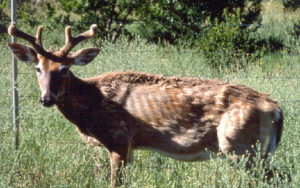
DEC and DAM Find No Chronic Wasting Disease in New York |
State’s Strategic Surveillance will Continue during Hunting Seasons; DEC Reminds Hunters to Remain VigilantCWD-Suspected Deer Determined to be a False Alarm The New York State Departments of Environmental Conservation (DEC) and Agriculture and Markets (DAM) today announced that Chronic Wasting Disease (CWD) has not been found in a suspected CWD-positive sample from an adult female deer killed by a bowhunter in Chautauqua County and submitted for testing as part of DEC’s routine surveillance efforts. An initial screening test performed by the Animal Health Diagnostic Center at Cornell University suggested the deer as a possible CWD case. DEC and DAM immediately sent additional tissue samples to the National Veterinary Services Lab (NVSL) in Ames, Iowa, for additional definitive testing. DEC conducts confirmatory testing on all suspected CWD samples. Final diagnosis from NVSL indicates CWD was not detected. Although CWD poses a serious threat to New York’s white-tailed deer and moose populations, there are no known cases of CWD transmission from animals to humans. In an abundance of caution, DEC will continue strategic CWD surveillance in Chautauqua County and around the state as deer hunting season continues. DEC Commissioner Seggos said, “CWD presents a tremendous risk to New York’s white-tailed deer and moose populations, our state’s deer hunting tradition, and the significant economic benefits to our communities. I commend our staff and partners at Cornell University and the New York State Department of Agriculture and Markets for quickly mobilizing for a potential response. This case highlights why we must remain vigilant to keep CWD out of New York and it is critically important for New York hunters and the public to partner with us to reduce the risk of CWD and protect our wild deer and moose population.” State Agriculture Commissioner Richard A. Ball said, “The Department will continue to assist DEC in our shared efforts to monitor for and control CWD in deer and elk farms. Following this latest sampling, we will remain focused on prevention through diligent surveillance and testing. We will continue working with our farmers to protect our wildlife and farm-raised deer.” The potential discovery of CWD triggered DEC and DAM to immediately initiate New York’s CWD Response Plan (PDF, 2 MB) prior to the regular deer hunting season, which begins Saturday, Nov. 17. If CWD was confirmed, DEC was prepared to establish a CWD containment area in the location where the deer was taken to determine the prevalence and distribution of the disease and to prevent the spread of CWD into other parts of New York. DEC would have enacted regulations requiring hunters to register and provide tissue samples of all deer harvested within the containment area and to prohibit movement of deer carcasses and high-risk parts (brain, eyes, spinal cord, tonsils, intestinal tract, spleen, and retropharyngeal lymph nodes) out of the containment area. In addition, the Department of Agriculture and Markets was prepared to work with all the deer farm owners in the area to monitor herds for compliance with the State’s CWD prevention program, to control animal movement from the farms, and to inspect the deer farms’ fences and structures for secure containment. Because CWD was ultimately not detected, such measures are not necessary. Hunters can protect New York’s deer herd from CWD by following these tips:
CWD is an untreatable and fatal brain and nervous system disease of the cervid family (deer, elk, moose, and reindeer/caribou) caused by an abnormal protein called a prion. It is in the same family of diseases as bovine spongiform encephalopathy (“mad cow” disease) and scrapie in sheep. CWD prions can be spread directly from animal-to-animal contact or indirectly from infected carcasses, parts, products, or contaminated environments. Prions are found throughout the body of infected animals, and live animals can shed prions in saliva, feces, and urine even before they appear sick. Once the ground is contaminated with CWD prions from feces, saliva, urine, or infected carcass parts, the prions can remain infective to other cervids for 16 years or more. DEC began monitoring for CWD in 2002 and intensified its efforts in 2005 after CWD was found in five captive and two wild deer in Oneida County-the first incidents of the disease in New York State. At that time, DEC took immediate action to contain the disease. DEC and DAM depopulated the affected captive herds and culled several hundred deer near the incident cases. Since then, DEC has tested more than 46,800 deer with no additional cases being discovered. DEC continues to annually monitor hunter-harvested deer for CWD, and DAM routinely tests a portion of CWD-susceptible animals in captive cervid facilities. More information about CWD is available on DEC’s website. To understand what NY is doing about CWD, read more in the CWD informational booklet (PDF, 10 MB). |
